By Patrick Cooney, Certified Fisheries Scientist
Finding Nemo is riddled with biological inaccuracies, including one that we previously explained: Nemo’s dad, Marlin, should have become a female (Marlene?) who mates with her own son, Nemo. Despite the animators missing an opportunity for an incredible biological plot twist, perhaps they were biologically accurate when making sharks Bruce, Chum, and Anchor feel guilty about eating other fish.
Biologically speaking, two of the three “Fish-Friendly” sharks that star in the Disney animated movie Finding Nemo have a dirty secret that originates long before they were even born. Perhaps their “fish are friends, not food” group counseling sessions really stem from their guilt of eating their own brothers and sisters while in the “womb”.
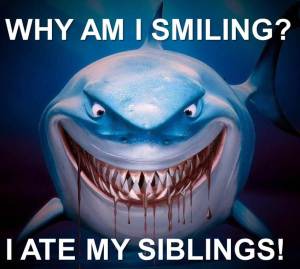
Bruce is a “Great” White Shark and Chum is a Mako Shark. Both of these sharks, along with 12 other known species, are characterized by attacking and cannibalizing their own siblings while in utero. On the other hand, Anchor, a Hammerhead Shark, is “off the hook”. Hammerhead sharks are not known to eat their siblings in utero. Interestingly, if Anchor was a female, she could be an exact clone of her mother through asexual reproduction!
Now, back to Bruce and Chum eating their siblings.
How can a shark even be in the “womb”? I thought fish spawned externally?
Sharks are an unusual grouping of fish in many ways and their reproductive anatomy is always a great place to start when exploring shark oddities like fetal cannibalism. Sharks are one of the few groups of fish that internally fertilize eggs and give live birth, which is why embryophagy* has only been documented in sharks!
What is special about male sharks that make them capable of internally fertilizing female sharks?
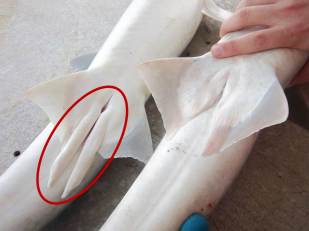
Male sharks have two penis like appendages called claspers. These appendages provide sharks (and skates and rays) the capability for intercourse and internal fertilization. Almost all other fishes lack clasper-like appendages and are therefore relegated to external fertilization.
Considering the importance of these sexual appendages for male sharks, it seems odd that the animators of Finding Nemo ended up “neutering” Bruce and Anchor. Only Chum has claspers…perhaps this is another opportunity for a plot twist: Bruce and Anchor are actually female sharks with deep voices!
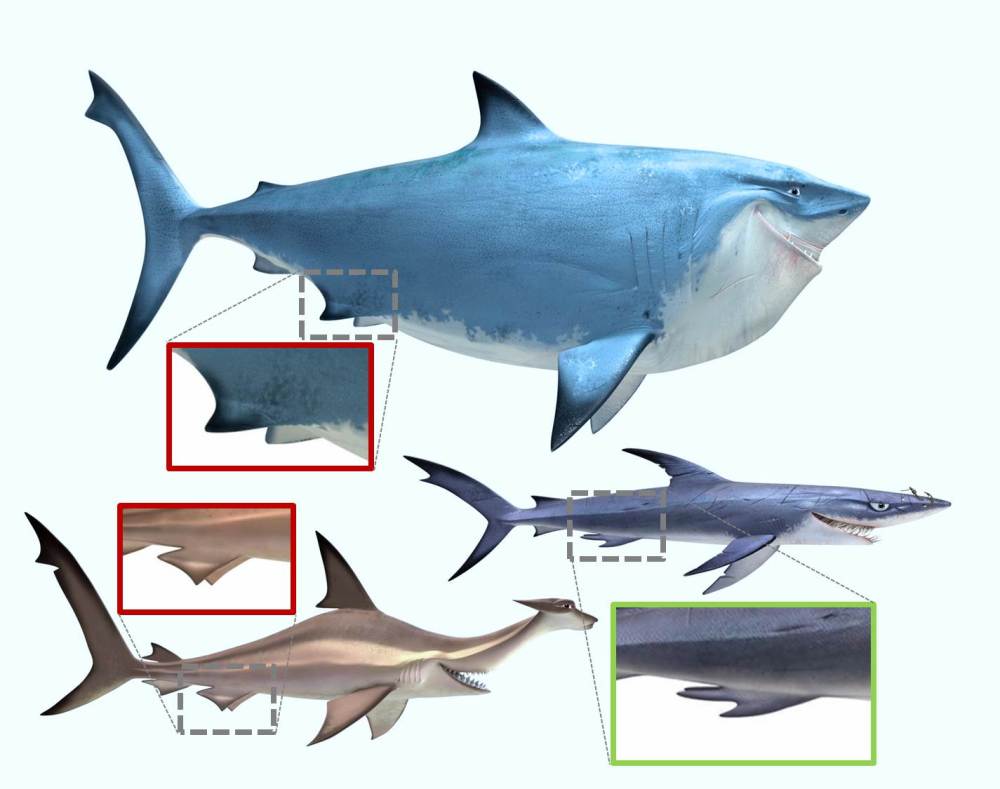
What is so special about female shark reproductive anatomy?
Female sharks have one cloaca and vagina that bifurcates into two uteruses. As with most vertebrates, female sharks release more than one egg at a time, therefore allowing for more than one embryo to develop simultaneously in each uterus. Sand Tiger Sharks are capable of being pregnant with 12 developing embryos at one time! But all that quickly changes in embryophagous sharks when one of the embryos develops faster than the others and gets hungry. The only prey around are their own siblings.
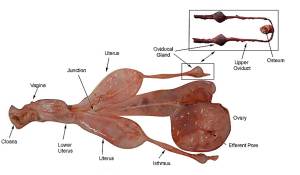
Even with large numbers of successfully fertilized eggs, the uteruses of embryophagous sharks are like gladiator arenas where only one fighter comes out alive. By having two uteruses instead of one, female sharks essentially shield the final two survivors from eating each other, therefore doubling the number of champions that emerge victorious.
Why do embryo sharks cannibalize each other?
The yolk sac provides nutrients for approximately the first half of gestation. As the yolk sac expires, embryos of embryophagous sharks look to their siblings and unfertilized eggs to provide the nutritional needs to carry them to term. Without turning on their potential brothers and sisters, none of the embryos would survive to birth.
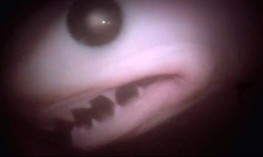
In the interest of survival, these little critters get ferocious. Even at a very small age, these sharks have incredibly sharp teeth that are able to rip their siblings apart and consume them in utero. One researcher, Dr. Steven Springer, even claims that his finger was perhaps mistaken as a rival sibling. The researcher was bitten on the finger as he reached into the uterus of a shark! That must be the rarest of shark “attacks” ever documented.
Are there advantages to this odd act?
Because adult female sharks are known to mate with multiple males, internal competition from sibling cannibalism could tip the scales favoring sharks who have offspring with rapid growth rates, therefore giving an advantage to larger and more robust sharks. Biologically, one could ask why don’t females just deliver the larger number of baby sharks as their yolk sac expires, therefore increasing the number at birth? Perhaps, by holding onto a few baby sharks for a longer period of time and letting them consume their siblings may actually increase survival rates in the long run by protecting the last two during the most vulnerable stage of their life.
http://channel.nationalgeographic.com/wild/sharkfest/videos/embryonic-cannibalism/embed/
Eat or be eaten.
Next time you watch Finding Nemo, and when you head to the theaters on July 17, 2016 to watch the sequel Finding Dory, hopefully you will understand the underlying issues that Bruce and Chum are facing when feeling guilty about eating fish. Further, next time you irrationally fear being “attacked” by a shark, think of all of the sibling embryo sharks that have a real rational fear in their eat or be eaten womb!
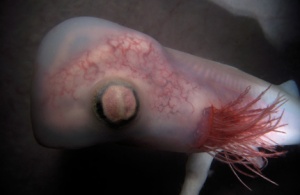
*A previous version of this story implied that White Sharks are embryophagous. Researchers currently believe them to be oophagous, meaning that they eat their siblings while still in the egg form. Thank you Jim Gelsleichter for pointing this out.
Please consider following The Fisheries Blog on Facebook and on Twitter (@FisheriesBlog).
Don’t miss another weekly article from The Fisheries Blog: Enter your email in the top left corner of this page.

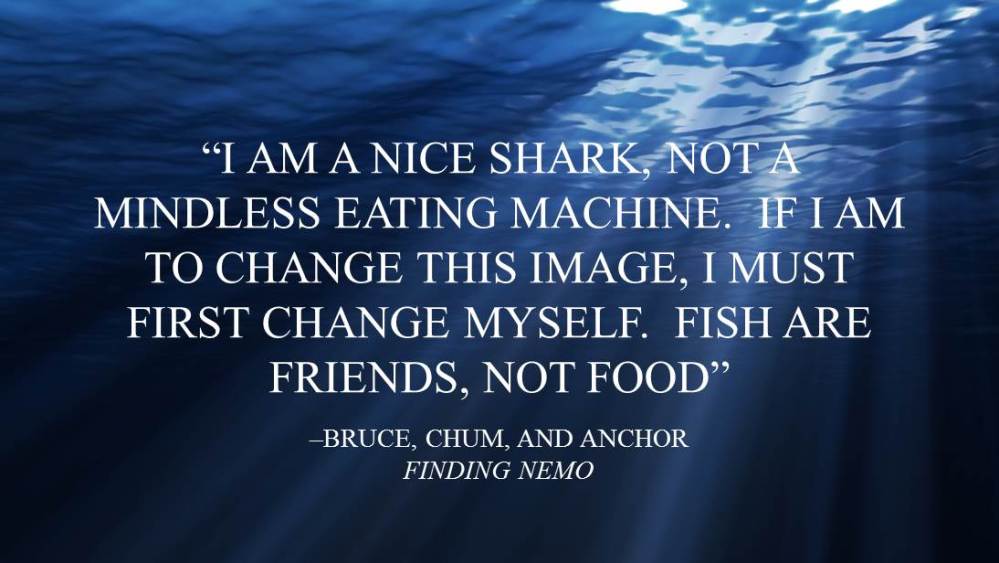
Good points about sharks.
If this were a documentary I would say Disney producers/writers have lost their minds. It is a kid/family movie. Disney has always been great about researching facts about the animals or cultures they use in their movies. They are also very sensitive to children, cultures, lifestyles, etc. In general, Disney’s goal is to create a fantasy world. They remove their guests and audiences from reality. They portray carnivorous animals (even extinct species) as having feelings and compassion and they even go as far as to present some cultures as kind and loving when they are not. The goal of this movie, and many others, is not to teach kids science, but instead to put a captivating story out there. I think they did a great job.
One more thing, Disney is really big on pushing some agendas. One of them is acceptance and breaking traditional thought (they call it stereotyping)….. I think they did just that with this film.
Finding Nemo and its sequel are products of PIXAR. NOT Disney!
Pixar is affiliated with Disney, and Disney is their publisher, but Pixar develops stories and characters on their own. Disney staff have nothing to do with it.
didn’t disney (not the man himself of course) shove lemmings over the edge of a cliff, creating
a very persistent myth?
Seriously ?